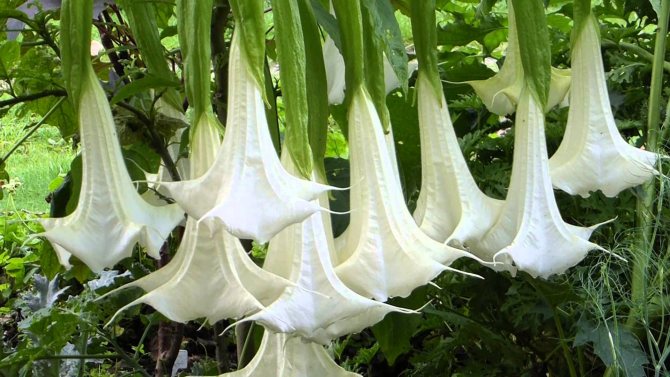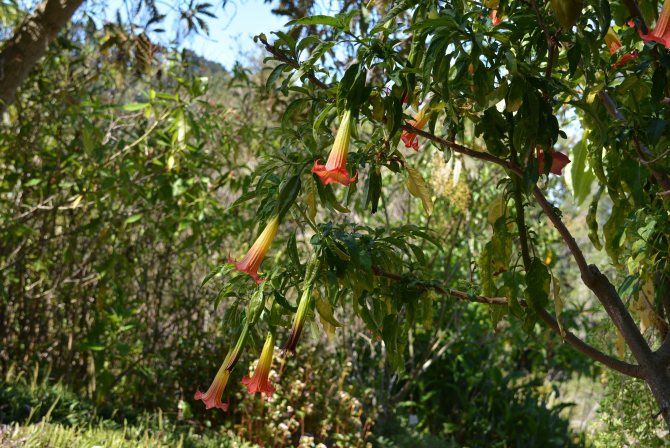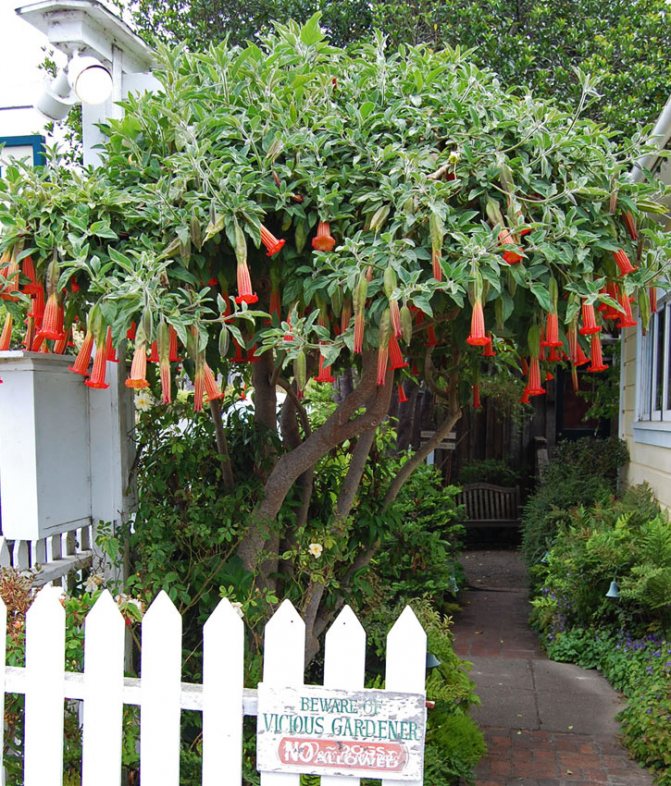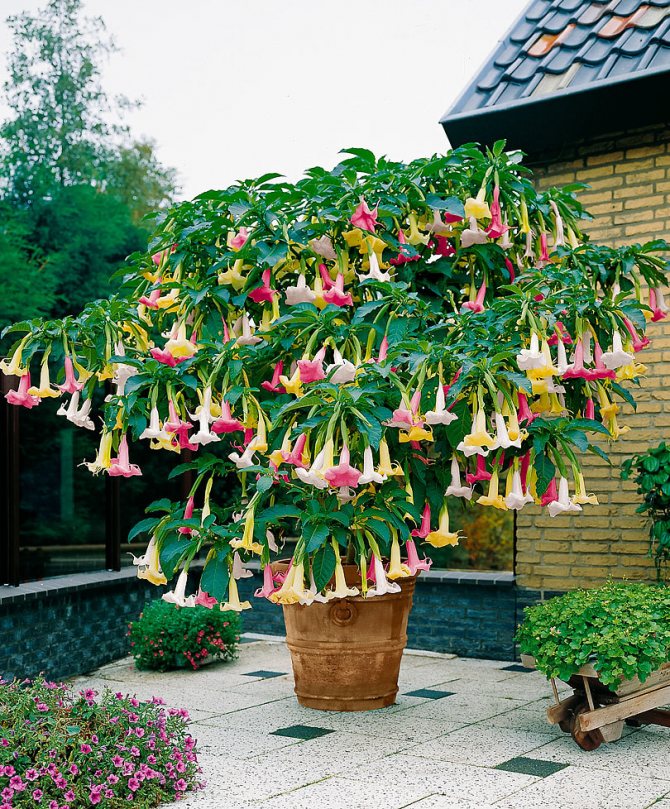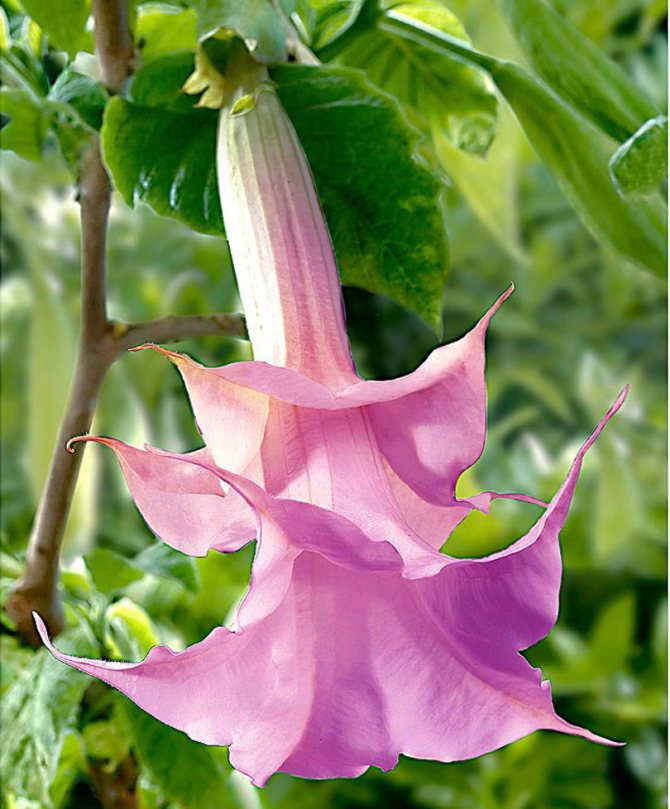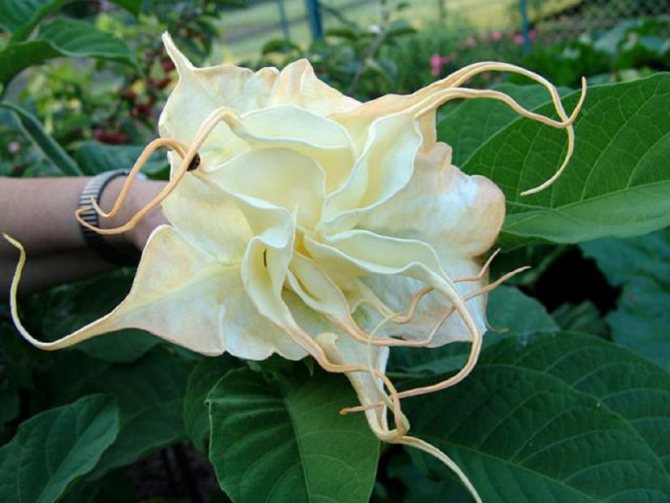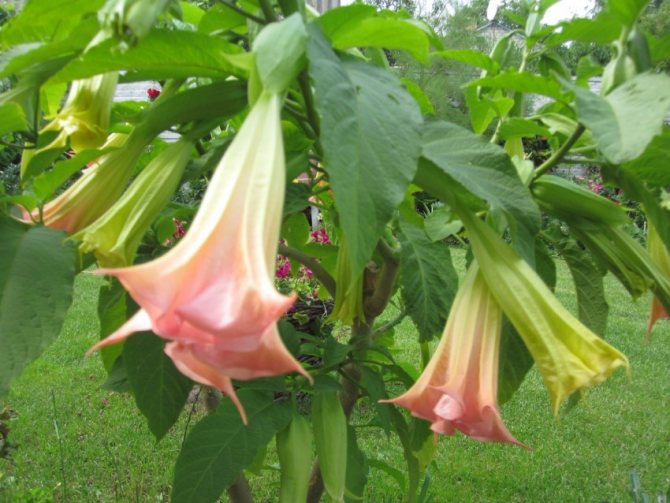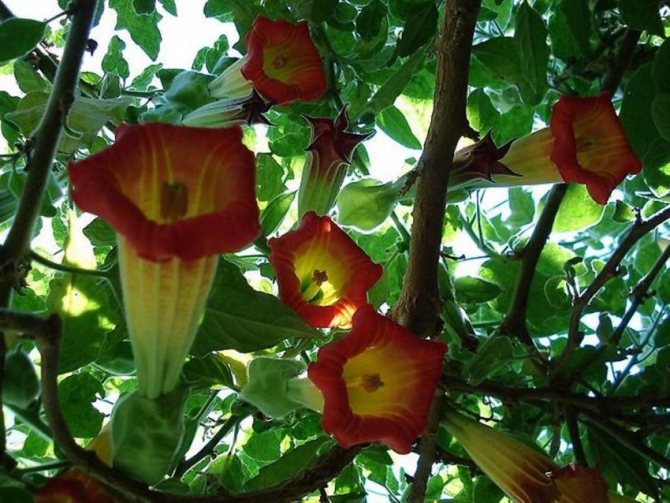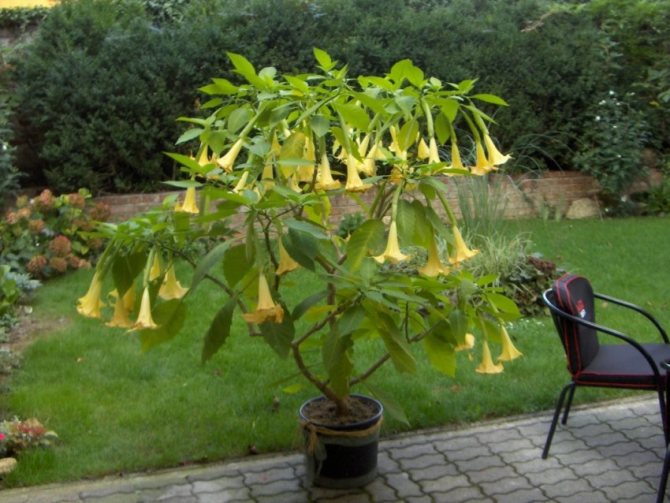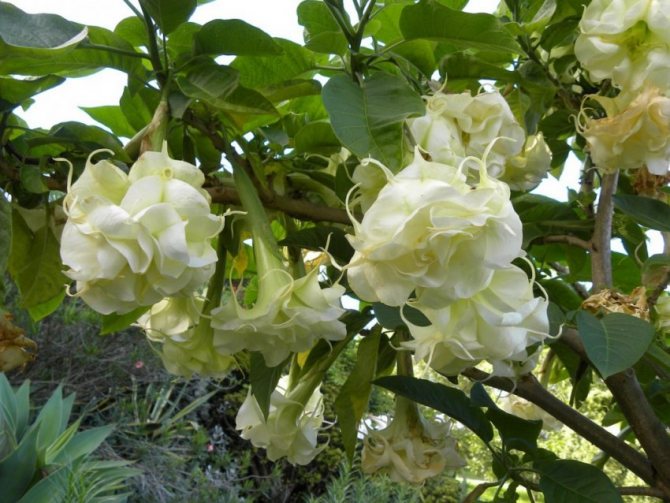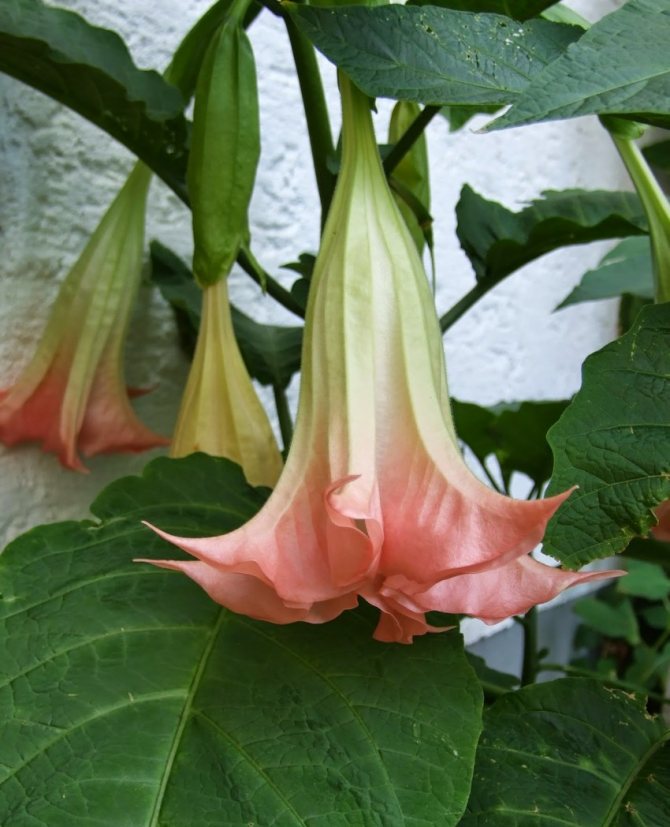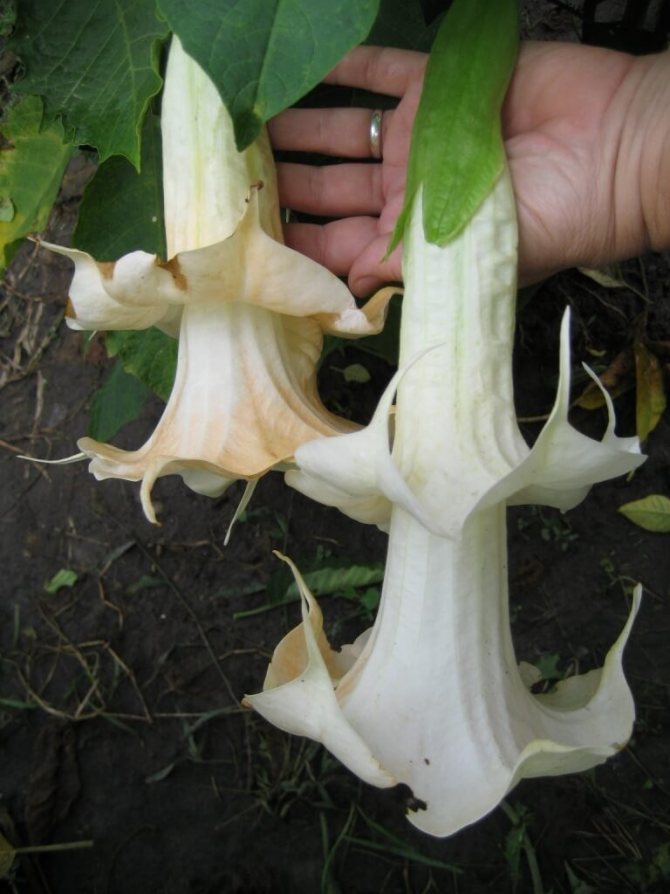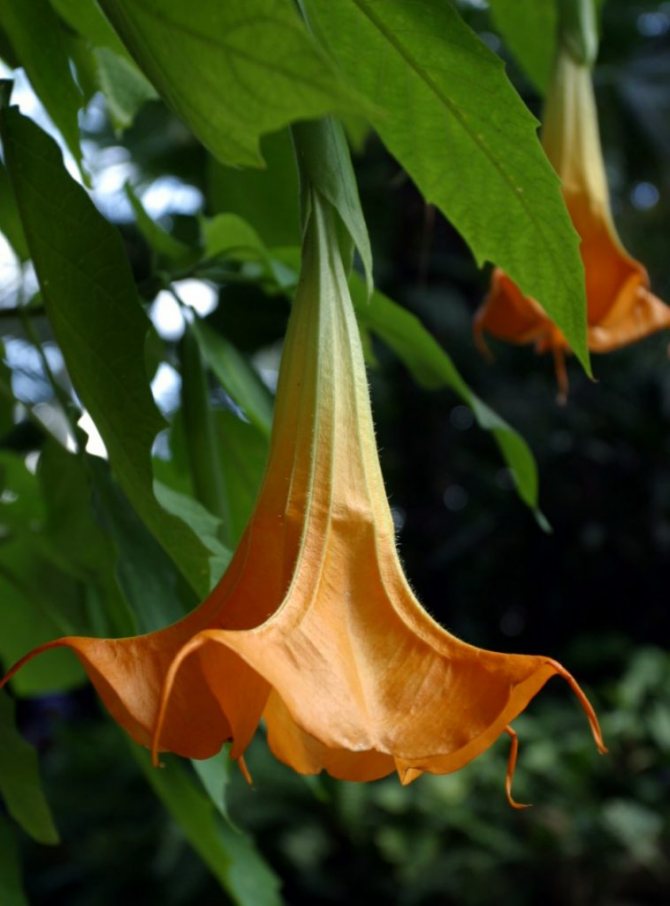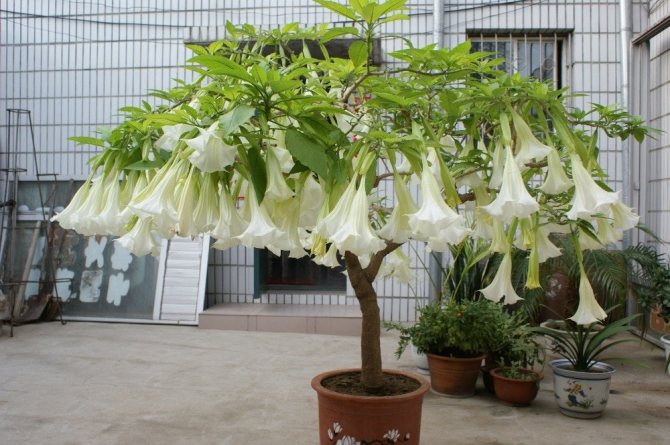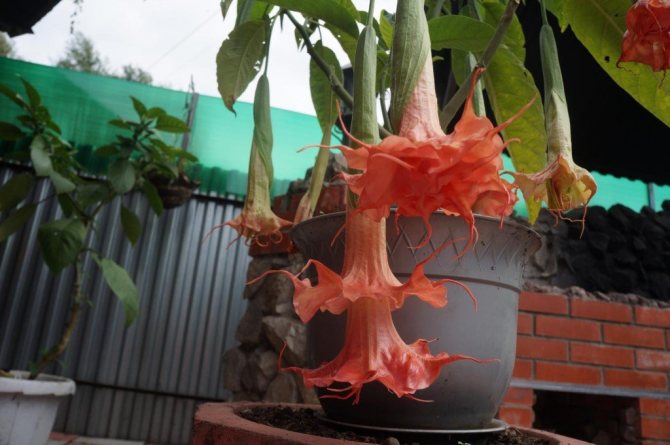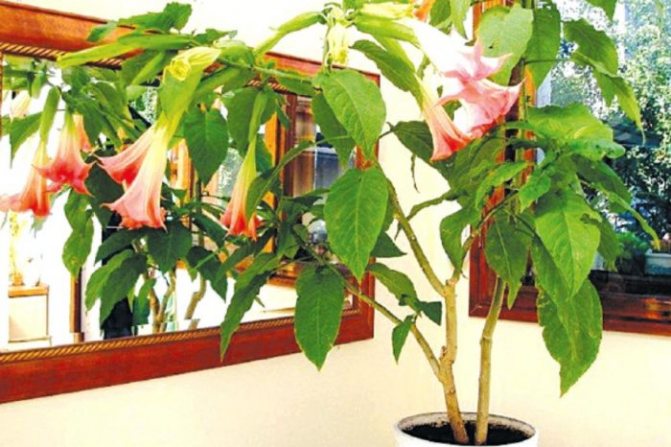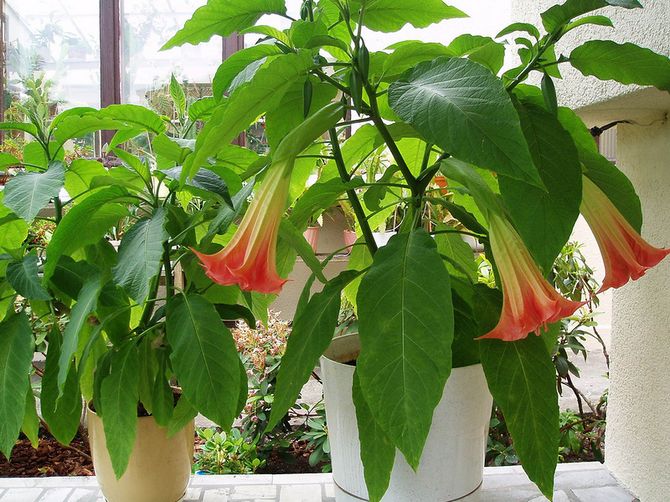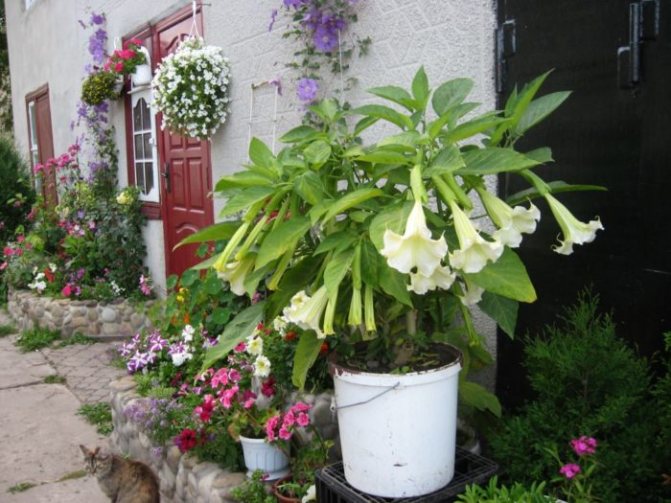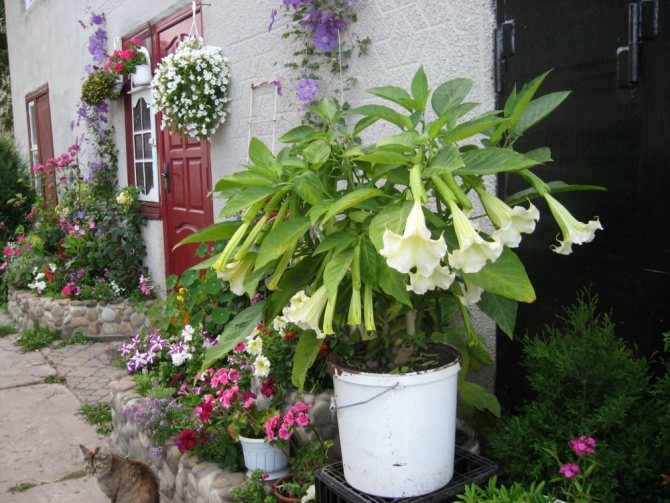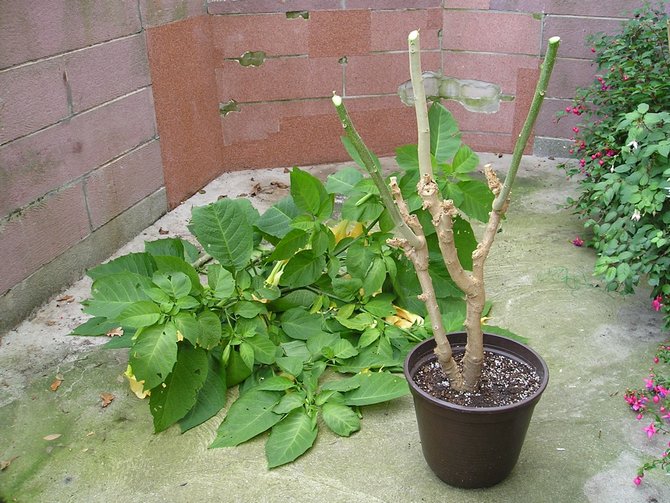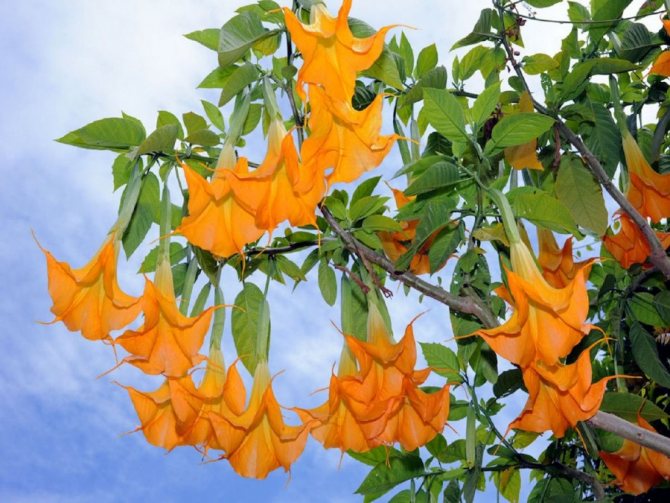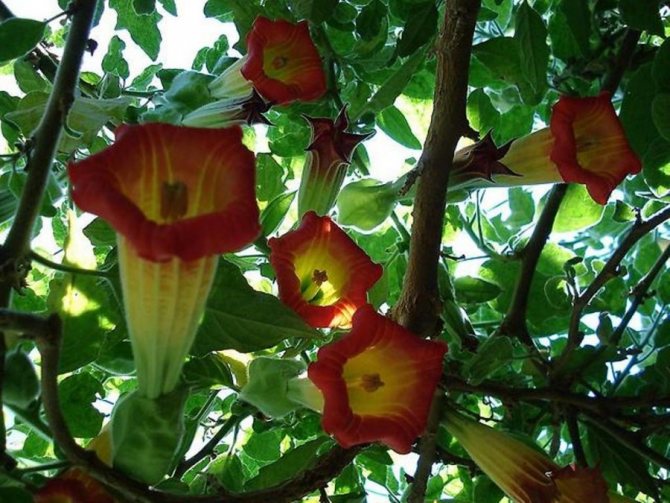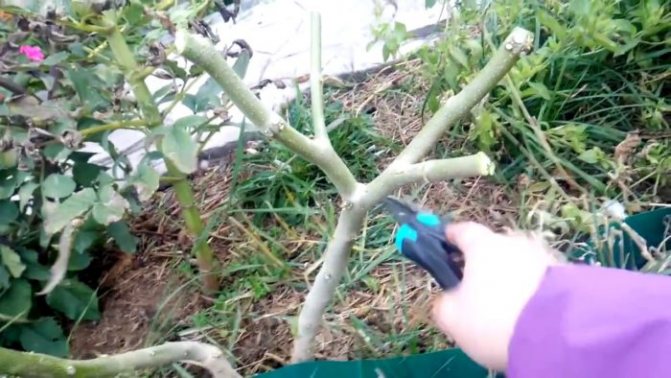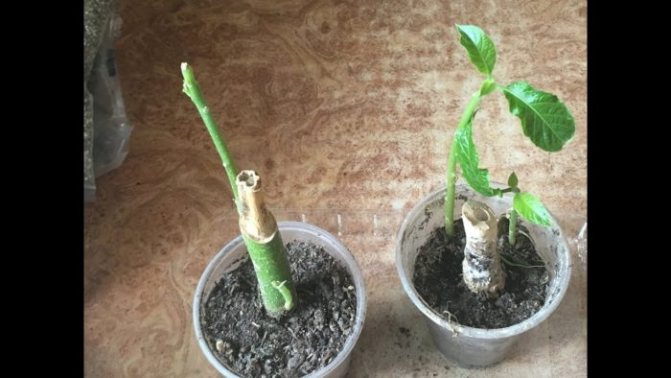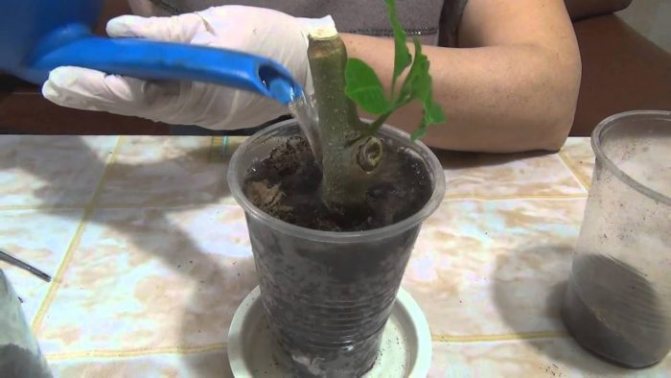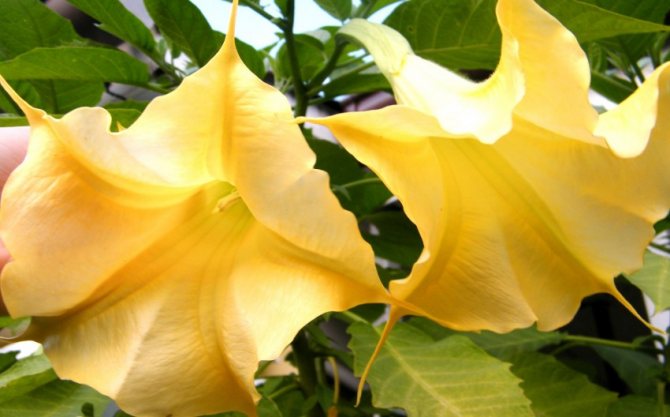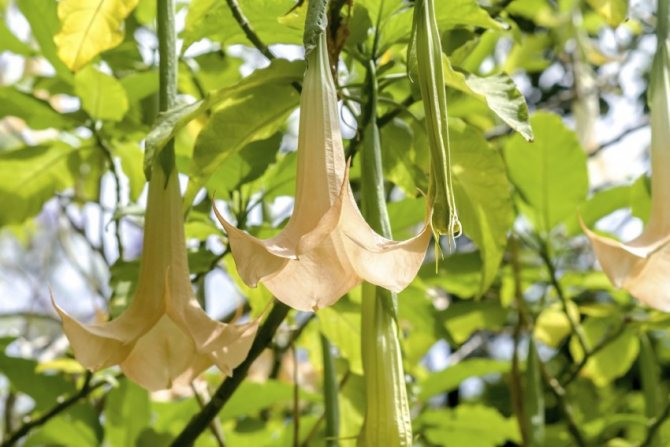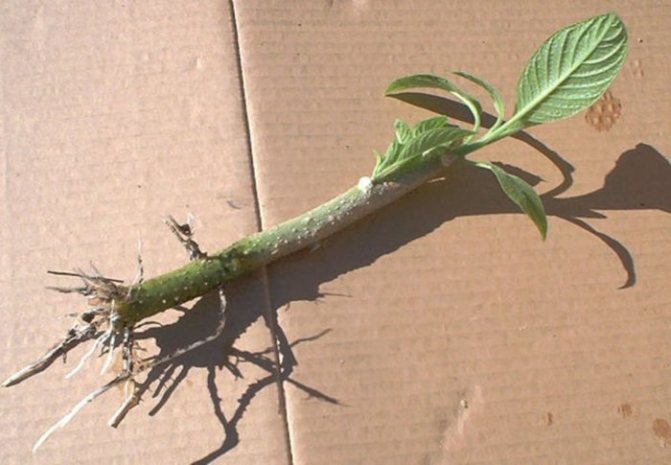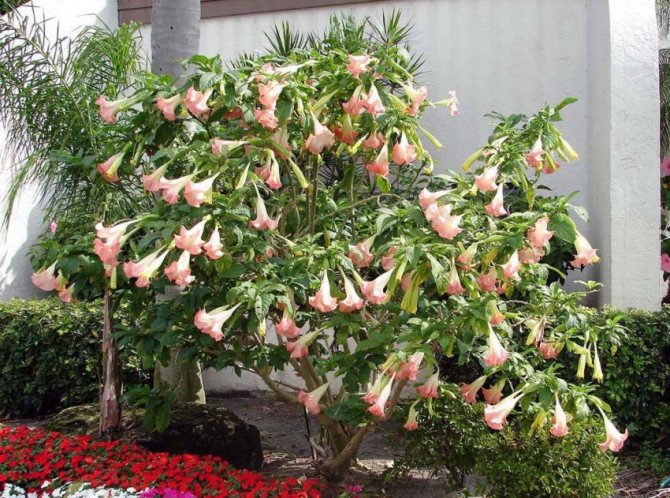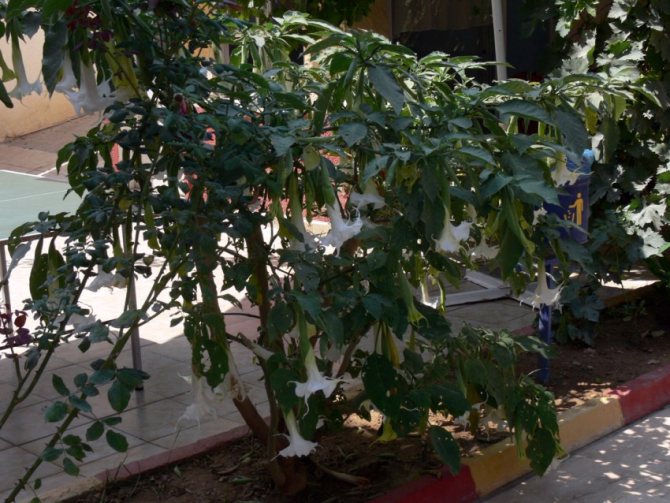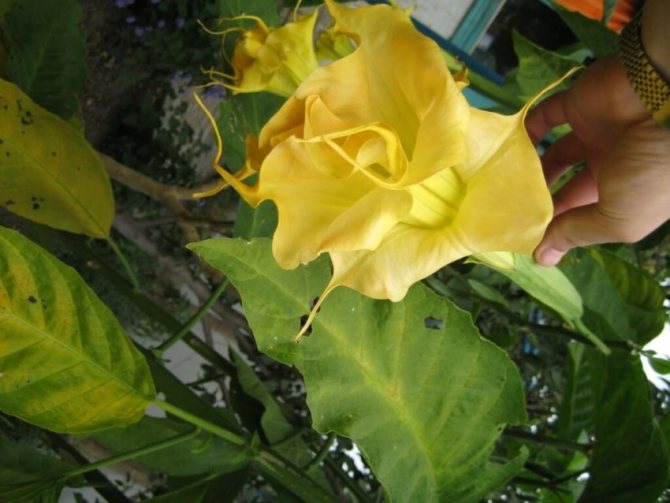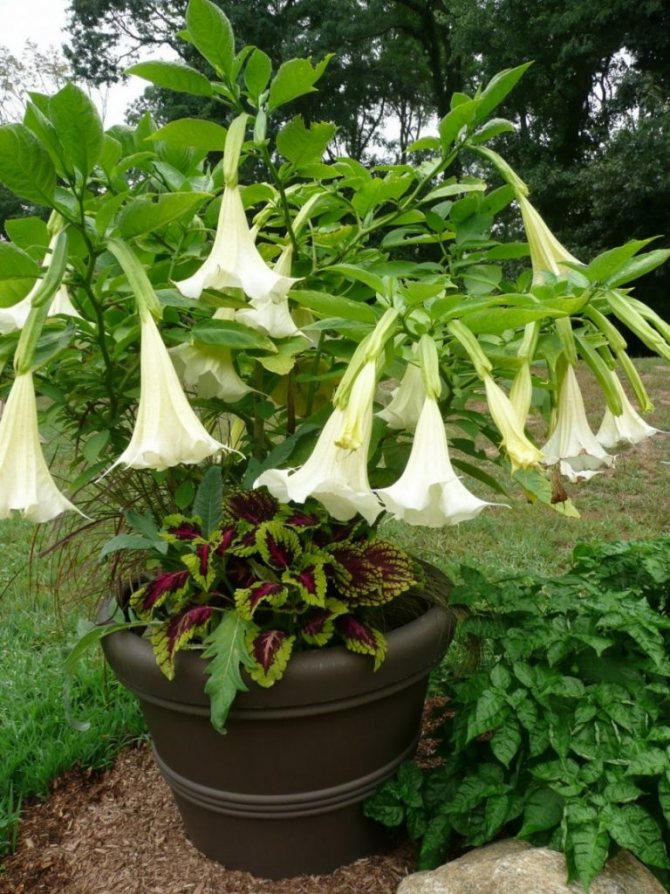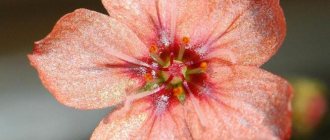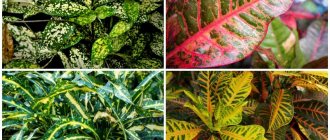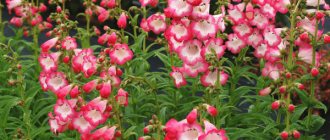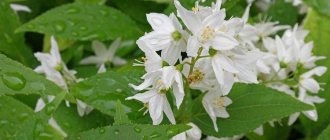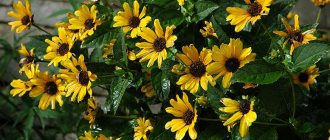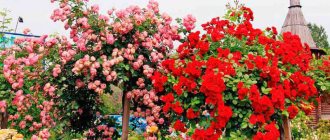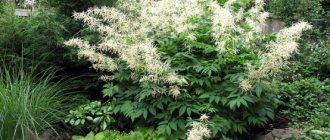This flower is a godsend for those who love exoticism. Brugmansia originates from the tropics of South America, at home it grows as an impressive tree, reaching 10 meters in height. The genus includes 8 species of evergreen trees. These sprawling plants make an unforgettable impression on people who first saw them. Flowers almost completely cover the greenery of the tree with huge gramophones reaching a length of 50 cm, and the diameter of the flower is 20 cm.

Flowers have a strong aroma and sometimes they are double flowers in some species. These flowers are also called "trumpets of angels" because of their shape. In addition to the memory smell, they have a wide variety of shades: peach, white, pink and yellow. Brugmansiya cannot be called a completely garden plant - after all, it is taken out there only for the summer.
Brugmansia was named after a Dutch physician living in the late 18th century. Today, its habitats are diminishing in the wild due to deforestation. How to grow roses - read here.
Popular varieties of brugmansia
A flower such as brusmania has a wide variety of species and varieties. Let's get acquainted with the most popular ones
Brugmansia aromatic (scented)
The birthplace of the plant fragrant brugmansia is Brazil. The hotter the climate, the better it grows. If you create comfortable indoor conditions, it will delight you with flowering all year round. But keep in mind - the shrub grows up to 5 meters in height. It is worth taking care of the appropriate ceiling height. Fragrant brugmansia has a white or light green flower, large in size. Some specimens reach 30 centimeters in length.
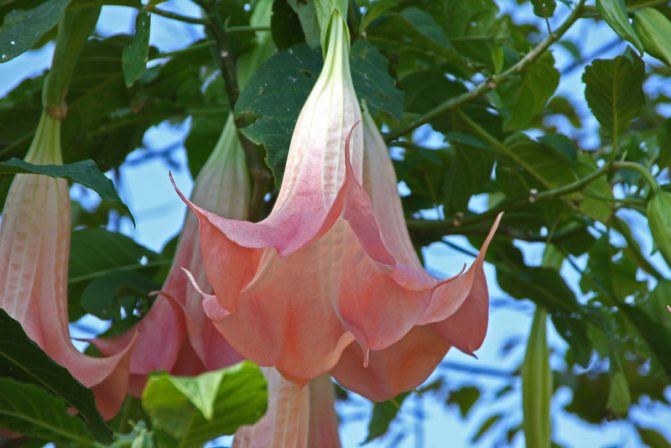

Aromatic Brugmansia variety
Brugmansia golden
Scientists do not know why golden brugmansia turns yellow. But the fact remains - the color of the flowers looks impressive. In addition, this species is easily recognizable by its long, rather large leaves. Some of them reach 50 centimeters in length.
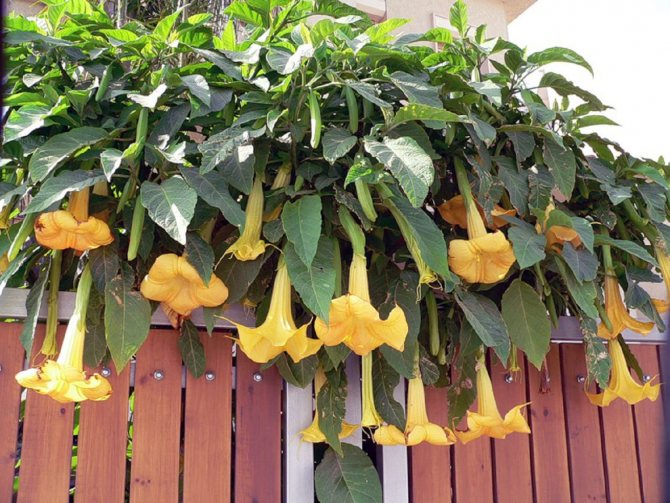

Variety Brugmansia golden
Brugmansia snow-white
The second name of this species is arboreal. In nature, it grows up to 3 meters, less in decorative conditions. The flowers are long, snow-white.
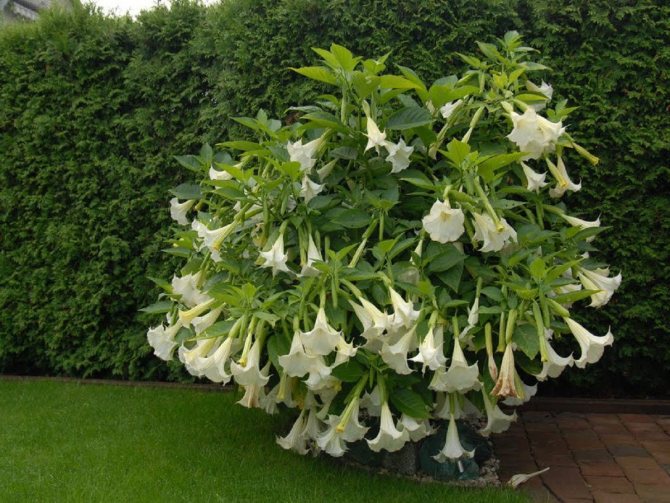

Variety Brugmansia snow-white
Brugmansia multicolored
This name was given to the plant for a reason. The flowering of multi-colored brugsmania is a whole story. At first, the flowers are white, but over time they become peach or even orange. Before you is a real record holder among giant plants. Reaches 4 meters, and flowers - 50 centimeters.
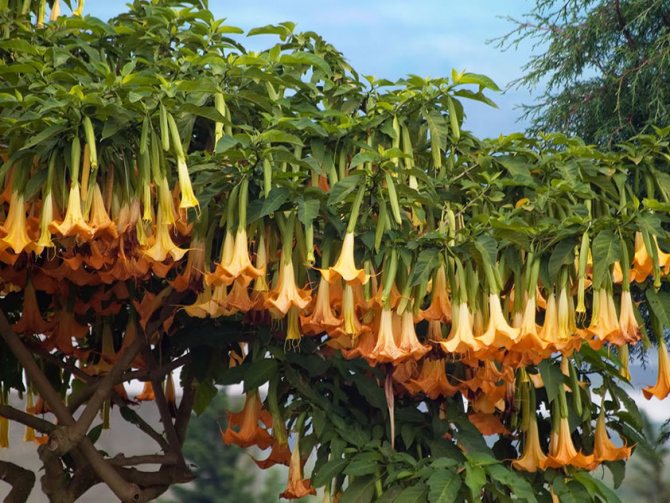

Variety Brugmansia multicolored
Is it possible to grow at home
In our country, brugmansia is grown as an exotic indoor or greenhouse decorative culture, which bewitches the eye with drooping flowers, endowed with large size by nature.
When keeping the culture indoors, foliage will not fall off. It is very important, when caring for a shrub, to adhere to the recommendations of specialists. This will allow you to grow healthy bushes that will delight you with abundant flowering every year.
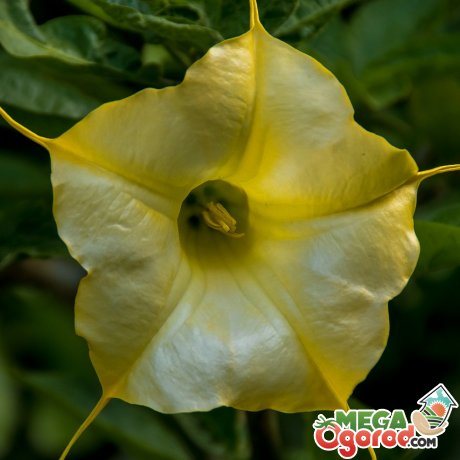

Features of growing brugmansia
To begin with, brugmansia can only grow and bloom profusely if it is grown in a warm climate. For the winter, the plant is always brought inside. Shrubs are initially planted in separate containers, since transplanting brugmansia is problematic.
Choosing a place
On the one hand, the lighting should be maximum, on the other hand, it is desirable to exclude drafts and strong winds. Due to the impressive length, the stems become fragile. Special supporting supports will help to solve the problem.
Soil preparation
When choosing a soil, preference is given to greasy, loamy soil... It has a good range of nutrients. Brugmansia seeds will sprout much faster, the germination percentage will be higher.
What do flower growers say about watering brugmansia?
Nowadays, brugmansia is grown in many countries of the world. One of the conditions for normal growth and flowering is timely, abundant watering. The leaves of the shrub are large and succulent, the stem is thick, the flowers are also large. And the root system is powerful enough. All this suggests that the peduncle needs a huge amount of moisture. Spraying should not be disregarded.
The best fertilizers
Brugmansia will grow normally at home only in the case of regular feeding. In liquid form, mineral fertilizers are applied 2 times a month. During the flowering period, fertilizers containing a lot of potassium are applied to the soil.
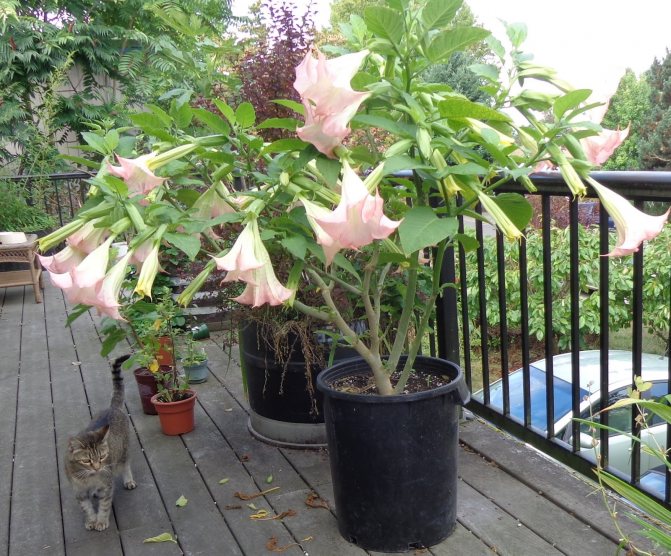

If you grow this plant at home, then only on the veranda or terrace - due to its large size
Pruning
Why do the leaves of brugmansia turn yellow, and the flowering is weak and inconspicuous? It is possible that you did not prune. Here are some helpful guidelines:
- When to conduct? The beginning of spring is the optimal time for the procedure.
- Pruning for brugmansia begins with the removal of old branches. Dry ones are removed completely, new ones - only 30%. By the way, cut branches can be used for propagation. We will return to this question later.
- Both straight and Y-shaped branches are left on the bush. The number of flowers will depend on them.
- The first pruning is carried out in the second year after brugmansia first bloomed.
- Most flowers will appear on the side branches.
Growing brugmansia on your site (video)
When to cook cuttings?
September and March are considered the best months for cooking cuttings of brugmansia for reproduction, however, experienced flower growers still recommend cutting in the spring, since this is the time of the awakening of nature, the plant resumes sap flow and thus takes root faster and better.


Another rule that cannot be neglected is that only those shrubs that are more than a year old are subject to cuttings.
Seeds, layering, cuttings - what to choose
How brugmansia multiplies, the issue of cultivation worries many flower growers. You can buy some brugmansia seeds in the store, give preference to cuttings or layering. Let's consider each method in detail.
Cuttings
The best option for spring, when you need to achieve fast rooting of cuttings. The florist prepares brugmansia seedlings with at least one branch. The length of the handle is arbitrary. The main thing is that he be strong and strong. Next, the leaves are cut. So you will save all the strength of the cuttings - they are necessary for normal development. The stalk is placed in a container of water. Previously, the lower part of the cutting should be dipped into the bio-solution. Water is changed daily. After 10 days, you can transfer the seedling with roots to the ground.
With poor root development, the cutting is immediately planted in moderately moist soil. The decayed element is trimmed. Contained at the optimum room temperature (greenhouse mode). From time to time, it is allowed to take out seedlings outside, under the rays of the sun. A month later, you can plant them on the street.
How to grow brugmansia from a cuttings (video)
Reproduction by layering
When propagation by layering is applied, brugmansia will be low, but cultivation will not affect the abundance of flowering. The optimal application period is May-June.
- Examine the top carefully.Find the strongest shoots there that appeared last year. Their diameter should be equal to 2 centimeters.
- Make an English Y cut in each shoot (25% of the thickness). Sprinkle with a commercially available root growth stimulant over the incision.
- Apply moistened moss, wrap with plastic. Use a thread to secure.
- The moss is watered with water for a month. It is very convenient to do this with a syringe.
- After 30-40 days, roots should appear. Leaves and flowers, as well as moss, are removed from the shoot. The workpiece can now be planted in a permanent area. Daily spraying, absence of direct sun rays will help to improve their rooting.
Seed propagation
Such methods of their reproduction, as seeds, make it possible to achieve flowering already in the second, maximum third year. All actions are performed in the following sequence:
- Soak the seeds for 2 days using stimulants.
- Plant in soil (1 cm deep), sprinkle with water.
- Cover the box for planting with foil, put in a bright place for 20 days.
- The emerging seedlings are sprayed with water at room temperature 2-3 times. When 5 flowers appear on brugmansia, planting and subsequent care are performed in the open field.
- After 2 months, the first fertilizers can be applied. Nitrogen-containing dressings are recommended. After another 2 months, complex fertilizers are added.
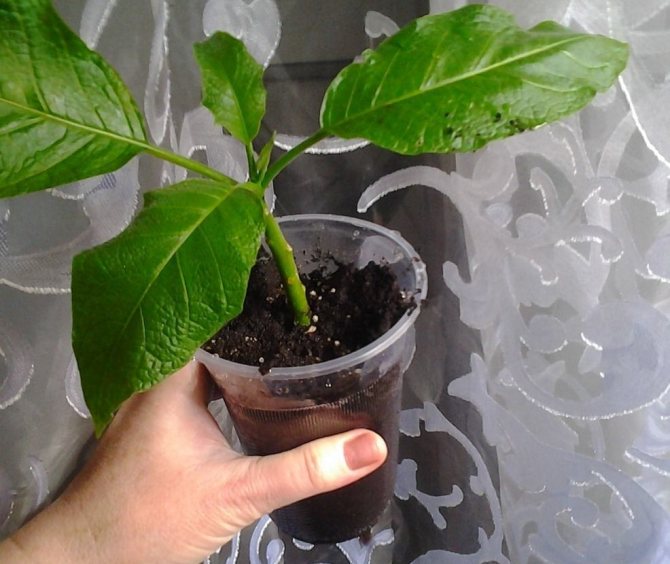

Brugmansiya from seed
Transfer
In order for the plant to grow healthy, it is necessary to use nutritious light earth for planting, which includes:
- low-lying peat;
- humus;
- garden land.
If desired, you can add a small amount of sand, perlite and vermiculite to the soil. By mixing charcoal with the soil, most fungal diseases can be avoided.
A large container for planting is chosen, since the shrub is rapidly gaining growth. The transplant is carried out in early spring, while the main points of growth have not yet had time to awaken. Small bushes are transplanted by transferring to a larger pot. In an adult dope, the top layer of the earth changes.
Before starting planting, a small part of expanded clay, charcoal and pebbles should be poured onto the surface of the bottom of the container. After that, a small part of the soil mixture is poured, and the rooted cutting is transferred to the pot along with the old clod of earth. The resulting voids are filled with nutrient soil. The earth is compacted and moistened.
Note! If necessary, during transplantation, you can slightly cut the roots of the plant, removing dying or decaying parts.
Subtleties of winter care
When growing brugmansia in cold latitudes, home care should be special. First of all, it concerns the air temperature. As soon as it drops below +5 degrees, the peduncle is transferred to a warm location.
Be prepared for the fact that in winter, regardless of the conditions of detention, the plant will drop almost all the foliage, it will not bloom. At +13 and below, hibernation is possible. The frequency of watering is reduced, but spraying is not stopped. As for ventilation, they should also be regular.
As soon as you notice swelling of the buds, transfer the plant to a bright place. This process usually starts at the end of February. The abundance of flowering in the coming year will depend on the amount of light.
Wintering - says the owner of brugmansia (video)
Choosing a landing site, soil composition
- The plant loves places with high levels of humidity and diffused but bright lighting. In this case, the crown must be protected from direct sunlight.
- The place must be selected in advance due to the large size of the brugmansia. But there are varieties bred specifically for greenhouses or indoor terraces.
- It is important to protect the shrubbery from sudden gusts of wind and drafts, as the leaves and petals of the flowers are windy, which can cause the trunk to break.
- If you plant in partial shade or place a tub there, then flowering is significantly reduced, but foliage will begin to grow abundantly.
- The soil should be very nutritious, with a neutral pH (acidity) level. No less important is the looseness and lightness of the soil. You can prepare the following soil mixture: mix until homogeneous 1 part of loam, 1 part of humus and 2 parts of peat. Then pour a light pink potassium permanganate solution over the substrate.
- Be sure to pour a drainage layer on the bottom of the container or planting hole. Put a lot of compost or rotted manure in the pit. The sprouts are transplanted by the method of transshipment with an earthen clod on the root system.
What is sick
Like any other plant, brugmansia can be attacked by insects or various diseases. We will explain in detail what are the most common diseases and pests of brugmansia, we will share the secrets of fighting them.
The spider mite is perhaps the main enemy of Brugmansia. To prevent this from occurring, spray the plant regularly, keeping moisture on each side of the leaves. Slugs and caterpillars are not uncommon, as are aphids. If you notice intruders, urgently use insecticidal preparations. Which ones, the consultant manager in the flower shop will tell you. As a rule, treatment is carried out 2 times a week until the pests are completely destroyed.
Due to poor, uneven lighting, improper watering, brugmansia loses some of the unopened buds, changes the color of the leaves. By following the basic rules of care, you can prevent these problems.
Why did the three-year-old plant never bloom, what is the problem with it? Most likely, top dressing is to blame - more precisely, their incorrect use. If you "go too far" with nitrogen-containing fertilizers, the leaf mass of the plant will increase, but the likelihood of flowering will decrease.
All kinds of spots and stripes, cessation of growth may indicate a serious viral infection. It is better to get rid of the diseased plant in a timely manner, otherwise it will infect the neighbors.
Protection against diseases and pests
Brugmansia is not susceptible to disease, however, improper care of the shrub often provokes the occurrence of rot. As a rule, the disease can be provoked by:
- excessive soil density;
- lack of a drainage system;
- frequent waterlogging of the earth.
Also, rot can occur against the background of a fungus. In order to cope with the problem, you will need:
- Remove the bushes from the tub.
- Prune rotten roots.
- Treat the ornamental culture with a fungicidal agent.
- Plant the bush in a pot filled with new potting soil.
Despite the fact that brugmansia is toxic, pests often harm decorative culture.
| Insects | Symptoms | Ways to fight |
| Weevil | On the extreme areas of the sheet plates, gouged zones appear. The buds that have not yet had time to open fall off. | Every 7 days, insecticidal treatment should be carried out until the weevils completely disappear. |
| Whitefly | Yellowing of the leaf plates and their further subsidence. Sluggish appearance of foliage and flowers. | Experts recommend using special insect traps and spraying with insecticidal agents. |
| Spider mites | The appearance of light points on sheet plates. Cobweb formation on the back of the leaf plates. | It is important to spray with Aktara as soon as possible. |
| Snails and slugs | Hole formation on green mass. | Experts recommend spraying with insecticidal agents like Actellik and Iskra. |
Precautions
Despite the magnificent appearance and dizzying aroma of flowers, certain precautions must be taken when growing a shrub. Some people who have heard the smell of brugmansia get headaches.That is why the shrub is prohibited for cultivation in some countries of the world. The toxins in the composition can cause hallucinations. This fact must be taken into account, especially if your family has children.
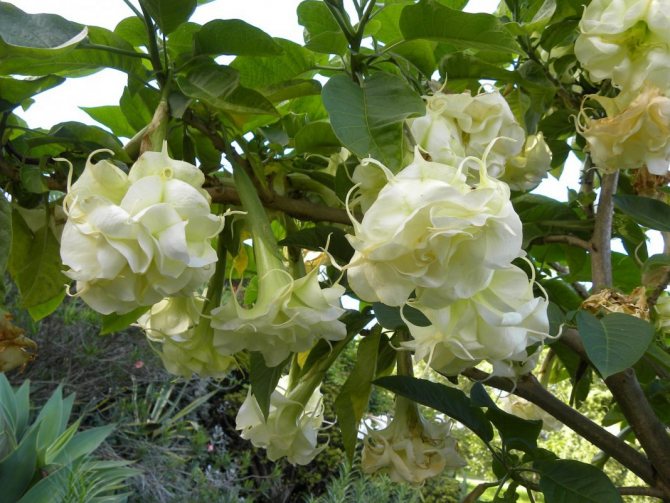

For all its beauty, remember that brugmansia is a poisonous plant, so be careful
Poisonous beauty
Brugmansia is very poisonous and the stems contain narcotic alkaloids that cause hallucinations. But in places where it grows in the wild, its alkaloids contained in the stems are used for rheumatic pains, for getting rid of parasites from the human body and for diseases of the throat. Therefore, sometimes this tree is called the devil's tree. If there is a child or an animal in the house, then it is necessary to abandon the cultivation of this plant.
When cutting, you need to be careful, because the juice of the plant that gets on the mucous membrane causes severe irritation and after contact, you need to rinse the place where the juice has gotten.
Now brugmansia is used in the pharmacology and biochemical industry to obtain atropine and scopolamine.
All about growing brugmansia
About weigels - read here.
What mistakes do flower growers usually face?
It cannot be said that Brugmansia is a princess and a pea, but there are a number of problems that Ukrainian flower growers who grow Angel Trumpets at home still face from time to time. We will list these problems so that you can avoid stepping on the same rake.
Falling foliage:
- reason: lack of water;
- way of help: regular watering, which corresponds to the temperature and humidity level in the house.
Thinning stems:
- reason: lack of sunlight;
- way of help: changing the location of the pot, using artificial lighting in the winter.
Slow growth:
- reason: lack of nutrients (or the plant has simply reached its maximum);
- help method: regular application of mineral fertilizers to the substrate.
Falling buds:
- reason: lack of water, “moving” of a flower from one house to another with a different temperature regime;
- help method: stabilization of the irrigation schedule, creation of favorable temperature conditions for the flower.
Common types of shrubs
The most popular types of brugmansia among gardeners are:
- fragrant, originally from Brazil, blooming all year round with white or greenish phonographs with dimensions up to 30 cm;
- golden, which received its name for the bright yellow coloration of flowers and impressive leaves of half a meter in size;
- snow-white, on the basis of which a lot of hybrids have been derived, with bright white flowers 25 cm in size;
- bloody, the name of which is justified by the shade of its inflorescences, although sometimes yellow shades are found; it has an attractive aroma, belongs to frost-resistant varieties;
- multi-colored, also justifying its name by color, the peculiarity of which is that the young plant surprises with white flowers, later acquiring yellowish-red shades.
Brugmansia, planting and caring for which pays for all worries, will delight the owners with its beauty and aroma.
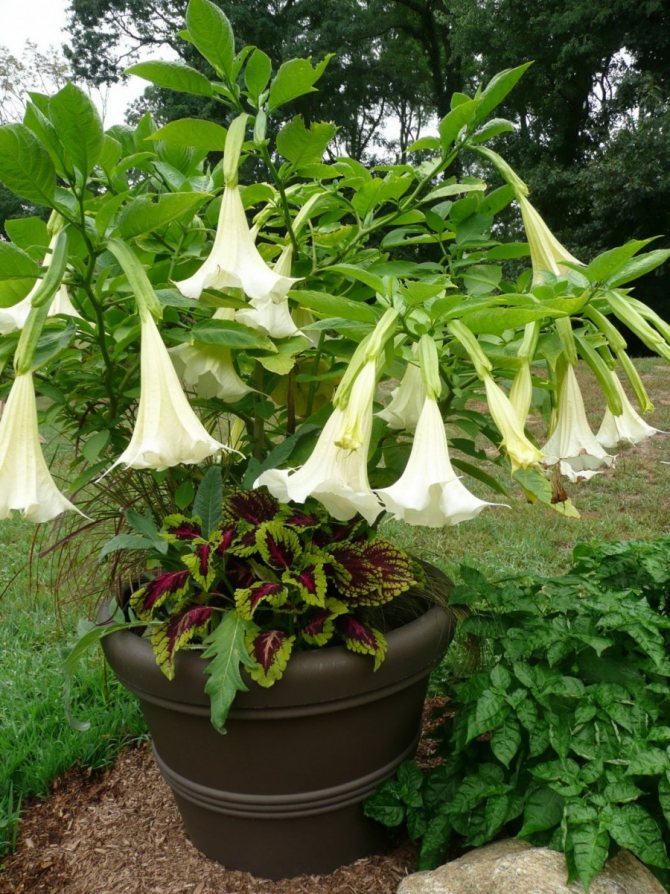

How to plant and grow from seeds?
Brugmansia every year it is becoming an increasingly popular type of ornamental plants, so it is not difficult to acquire its seeds, they are sold in many specialized stores.
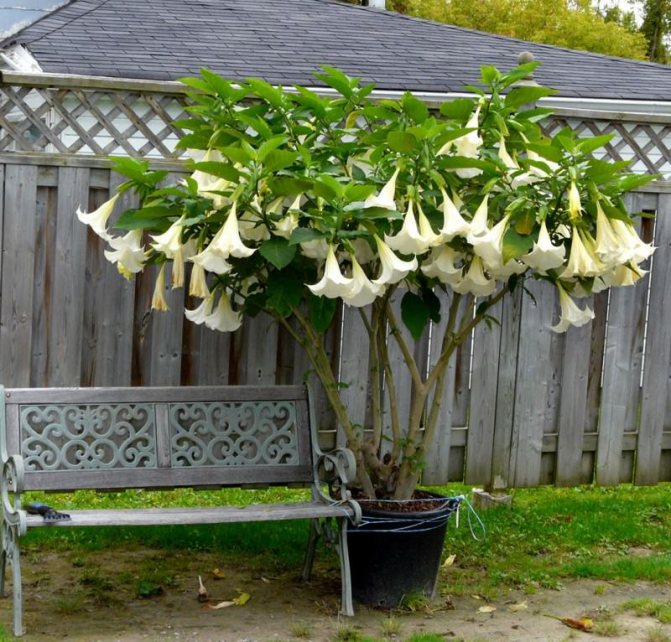

At the moment, many different varieties and hybrids of this plant have been bred, and without that a wide range of species continues to grow gradually, the seeds themselves are quite large and most often have a brown or green color.
Growing brugmansia in this way has a number of nuances that you need to know:
- Usually seeds are sold in 3-5 pieces, the F1 marking on the package or the Gibrid inscription denotes a hybrid variety.Most often, in such situations, 2-3 specimens, when they grow up, will not have significant resemblance to the mother plant. If you buy ordinary seeds, then such mutations are virtually excluded.
- The most suitable date for planting - this is the period from the last days of January to March, but disembarkation can be carried out at any other time of the year.
- Best for planting use special wide containers for growing flowers or small-sized home greenhouses. The use of separate containers is allowed, but their volume must be equal to 0.2 liters or more.
- For growing you will need loose and fertile soilwhich must first be moistened.
- Seed germination of brugmansia averages 70-80%, but this indicator can be increased if they are previously soaked in a solution of heteroauxin for several days.
- Seeds lay out on the surface and cover with soil, the thickness of the top layer should not exceed 1 cm.
- After manual compaction of the soil it must be watered, and then pull the transparent film on top.
- Thereafter the soil should not be allowed to dry out, but it is also not allowed to fill it too much, therefore watering is carried out only with the help of a sprayer.
- Keep the pot in a warm place after planting seeds in it. with good lighting, but avoid direct sunlight.
- Each seed sprouts at a different time on average, it takes them from two weeks to one and a half months for this process. After the appearance of the first shoots, the film must be removed from the pot, watering must also be carried out using a sprayer and at least 3-4 times a day.
- When several months have passed after the seed germination, Brugmansia must be taught to the sun. This is done gradually, the pot is exposed in a sunny place only in the morning and evening hours, after a while it can be left under the sun throughout the day.
- After the first appearance of leaves in seedlings they must be seated in separate pots, the minimum volume of each should be 0.5-0.7 liters.
- Thereafter need to constantly change pots as the plant grows, since its roots will be cramped in a small container. In just the first year, 3-4 transplanting shoots are usually carried out, after this period, brugmansia usually has a height of 25 to 60 cm.
Video review
Brugmansia is a bush belonging to the nightshade family, with a tree trunk, large lush flowers in the form of phonographs and a heady, easily recognizable fragrance. Under natural conditions, the plant is found in tropical and subtropical zones, prefers a hot climate in which an outlandish flower amazes with its flowering year-round and turns the site into a picture of fantastic beauty, which is confirmed by the photo of brugmansia. In a cool environment, it blooms much less often.
Pruning
It is important to know that brugmansia needs pruning, since its flowering depends on it. It is necessary not only to subject her to this procedure, but also to do it correctly and in accordance with the rules below:
- Pruning is not allowed at any time after March.
- When pruning, even as complete as possible, it is necessary to preserve a certain number of formed branches in the form of the letter Y, since without them the brugmansia will cease to bloom.
- Usually, when pruning, the following parts of the plant are completely removed:
- crown that has become too thick;
processes with fractures or other types of damage;
- diseased branches.
- Young bushes are best pruned only one year after their first flowering.
All other elements of the bush are only shortened by a third of their length.
Description
Brugmansia was originally classified in the nightshade group, a subclass of Datura. As it was studied, a separate genus of 8 species was identified.For its unusual shape, the long delicate flower of brugmansia was named "Angel's Trumpets".
The plant has a tree-like trunk and a spreading crown with juicy oblong leaves. Flowers drooping, long, up to 20 cm, represent an elongated cone ending in a wide bell. The colors are very diverse. During flowering, the leaves are completely hidden under the flowers.
The flowering period depends on the conditions. With proper care, Brugmansia begins to bloom in July and when transferred to a house in the fall, it can continue to bloom throughout the winter. For a strong, slightly intoxicating smell, the plant was named "intoxicating tree". It is characterized by a change in aroma during the day and its intensity.
Brugmansia can shed its flowers completely during illness and partially, replacing them with new buds.
The sap of the stems and leaves of the plant causes hallucinations, disorientation. Flowers and seeds are poisonous. Children may start vomiting, convulsions.
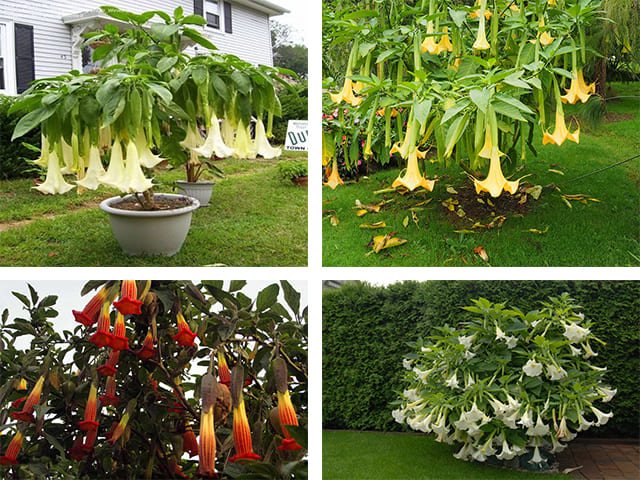

We select the soil for the flower
Under natural conditions, brugmansia grows on very fertile loams, therefore, for good development, you need to choose the correct soil composition. To prepare the soil mixture, one part of vermicompost and clay soil are used, mixing them with two parts of peat. This soil is suitable for growing an adult plant and sowing seeds.
Before use, the soil mixture must be disinfected. For sterilization, a solution of potassium permanganate is used, with which the earth is abundantly watered.

